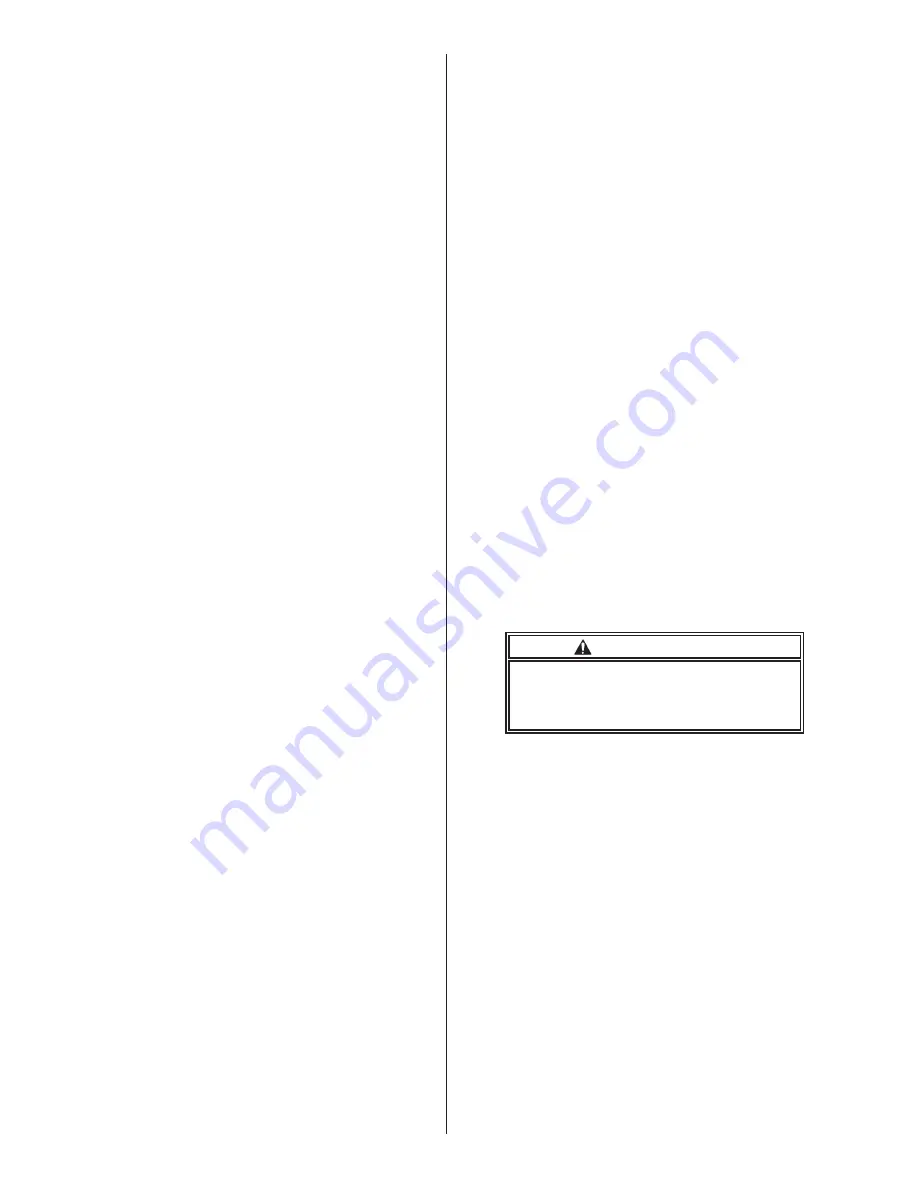
SURVIVAIR Opti-Fit
™
Convertible Facepiece
15
they are to be used. Used filters must be stored in
a protective bag, and in a clean, dry environment.
Detailed guidelines for each filter series are pro
-
vided below.
1. N-Series Filters
These filters are only NIOSH approved for use
against solid and water-based particulates
and must not be used in any area that con-
tains oil aerosols. N-series filters capture par
-
ticles using electrostatic charges, and these
types of filters may be subject to some loss of
efficiency if they are exposed to certain liquid
aerosols. The N-series (N95 and N99) filters
must be replaced immediately whenever:
● they are damaged, soiled, soaked with
liquids such as water or alcohol, or ap-
pear to be suspect or damaged in any
manner, or
● the user notices an increase in breathing
resistance such that the respirator be-
comes uncomfortable to wear.
If none of the above occurs and there is a
respiratory protection program per OSHA
29 CFR 1910.134 in place, then these filters
may be used continually, but only for a maxi-
mum of 30 days or 40 total hours, whichever
comes first. However, SPERIAN recommends
that all filters be replaced daily because the
user may be unable to detect small defects
resulting in a loss of filter efficiency, and the
determination of when breathing resistance
becomes too uncomfortable is subjective.
Further, SPERIAN recommends that these
filters be replaced daily when there are any
liquid aerosols present and there is no respi-
rator program in place.
2. R-Series Filters
These filters are NIOSH approved for use
against any type of particulate, except that
for atmospheres that contain oil. The filters
can only be used for 8 hours or a single shift,
whichever comes first. When used in either
oil-containing or non-oil containing atmo-
spheres, these filters must be replaced im
-
mediately whenever:
● they are damaged, soiled, soaked with liq
-
uids such as water or alcohol, or appear to
be suspect or damaged in any manner, or
● the user notices an increase in breathing re
-
sistance such that the respirator becomes
uncomfortable to wear.
If none of the above occurs, the filter is used
in an area that does not contain oil, and there
is a respiratory protection program per OSHA
29 CFR 1910.134 in place, then these filters
may be used continually, but only for a maxi-
mum of 30 days or 40 total hours, whichever
comes first. Even when used in non-oil con
-
taining atmospheres, SPERIAN recommends
that all filters be replaced daily because the
user may be unable to detect small defects
resulting in a loss of filter efficiency, and the
determination of when breathing resistance
becomes too uncomfortable is subjective.
3. P-Series Filters
These filters are NIOSH approved for long
duration use against any type of particulate.
When used in either oil-containing or non-oil
containing atmospheres, these filters must be
replaced immediately whenever:
●
they are damaged, soiled, soaked with
liquids such as water or alcohol, or ap-
pear to be suspect or damaged in any
manner, or
● the user notices an increase in breathing
resistance such that the respirator be-
comes uncomfortable to wear.
If none of the above occurs and there is a
respiratory protection program per OSHA
29 CFR 1910.134 in place, then these filters
may be used continually, but only for a maxi-
mum of 30 days or 40 total hours, whichever
comes first. However, service time for the
Model 1050 P100 filter can be extended if fil
-
ter performance to 42 CFR Part 84 can be
demonstrated. Whether used in oil-containing
or non-oil containing atmospheres, SPERIAN
recommends that all filters be replaced daily
because the user may be unable to detect
small defects resulting in a loss of filter effi
-
ciency, and the determination of when breath-
ing resistance becomes too uncomfortable is
subjective.
WARNING
Failure to properly assemble filter pads
to cartridges or filter holders can cause
leakage, which could lead to personal
injury, illness or death.
1. Return to fresh air.
2. Remove cartridges or P100 filters by
turning them counterclockwise. Dispose
of used cartridges and filters in accor
-
dance with Federal, state, and local
guidelines.
3. If using filter pads, remove the filter re
-
tainers from the cartridges or filter hold
-
ers. Remove the used filter pads and
dispose of them in accordance with Fed-
eral, state, and local guidelines. Clean
the filter retainer and cartridge or holder
if necessary.
4. Install new P100 filters or filter pads,
taken only from sealed packages, as
described in Section VIII, Part A.1.C.
5. Perform a facepiece fit check as de
-
scribed in Section VIII, Part A.3.





































